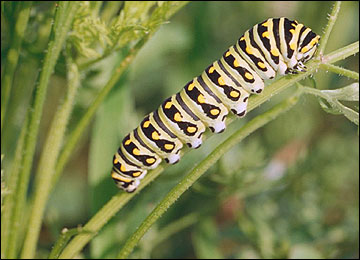Parsleyworm
Swallowtails
 Parsleyworm caterpillars (Papilio polyxenes) are present from May to October. They produce three generations per year.
Parsleyworm caterpillars (Papilio polyxenes) are present from May to October. They produce three generations per year.
The color patterns of the parsleyworm caterpillar change dramatically as it grows older. Initially, the young caterpillar resembles a bird dropping — glossy black with a white saddle-like spot on the first and second abdominal segments. By the time the caterpillar is full-grown, it is primarily green, with a thin transverse black line at the anterior portion of each body segment. There is also a thick transverse black line in the middle of each body segment containing yellow-orange spots. Host plants include vegetables such as parsley, parsnip, carrots, and celery, and the herbs anise, dill and caraway, and many umbelliferous weed species. Adults are called the black swallowtail butterfly.
About the family
Swallowtail caterpillars of the Papilionidae family are usually smooth-bodied and vary in color from green or yellow-orange with black markings to a color pattern that gives them the appearance of a bird dropping or the head of a vertebrate with conspicuous "eyes." All swallowtail caterpillar species possess a scent gland called an osmeterium that is located just behind the head. When disturbed, this fleshy-looking, forked, orange-red gland is everted from its pouch and releases a disagreeable odor. Because the caterpillars are relatively large and very colorful, they too (with royal and silkworm caterpillars) are quite noticeable. Very few species would be considered important pests. Many adults from this family are colorful and beautiful medium-size to large butterflies. Their name is derived from the presence of tail-like projections on the hind wings.